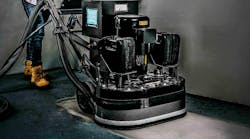When looking at ways to reduce your lighting bill, it’s not just about energy-saving bulbs—the flooring beneath your feet could hold the key to cutting your energy consumption. Here Dave Bigham, director of global training initiatives at surface preparation specialist National Flooring Equipment, explains a simple way that facilities managers can cut their energy bills.
When choosing a floor covering such as epoxy or carpet, it can be tempting to base your decision primarily on how the floor will look. Polished concrete is a popular flooring choice due to its durability and pleasing aesthetic. However, one of the most overlooked benefits of polished concrete is its ability to illuminate a room. A facilities manager may not typically consider energy-saving when the floor needs replacement or repair, but it can pay to do so.
A commercial or industrial floor will typically need replacing every ten years. When deciding on the covering to put down on the new floor, the facilities manager should be aware that polished concrete is usually at least 30% more reflective than any other floor option. The added reflection can reduce the number of lights required in the facility by 50%.
Halving the number of lights in a facility will greatly reduce the energy required to operate the lights. As well as this, in the warm summer months, fewer lights will mean less heat is generated, which will have a knock-on impact on the amount of air-conditioning required. In large retail, manufacturing or warehouse facility, the savings can be huge.
Built to Last
A polished concrete floor is straightforward to prepare in both new and existing buildings, although the aesthetic will be different in older facilities. When creating a polished concrete floor, the contractor will remove the covering and polish the concrete underneath. The facilities manager can specify the desired shine using a gloss meter and the contractor will adapt machine and tool choice to suit the desired finish, which will usually range from a grit of 400 to 3,500. A salesroom may prefer a considerably shinier finish to highlight the products, whereas, in a warehouse where customers do not visit, the manager may not be so concerned by the final appearance.
During the preparation, no harsh chemicals are required, which makes it a popular choice in hospitals or food processing environments. By opting for wet polishing, the facilities manager can be sure that no dust is released into the environment. As well as this, once the floor is polished it is instantly ready, there is no cure time, which reduces the downtime for the business.
The savings don’t stop there. Unlike other coverings, polished concrete floors do not require regular replacement, they can last for around 100 years. The maintenance required is minimal, which saves further time and energy to keep the floor up to standard. Unlike epoxy, wood or carpet a polished concrete floor does not hold dust, mites or allergens, which makes it easy to clean.
The reduced maintenance, energy cost, and downtime can save a facility manager thousands compared with conventional floor covering choices. The reduction in energy, labor, and maintenance combined with its life expectancy makes it a fantastic, environmental choice.
Any facility can reap the rewards of polished concrete. So, next time you’re looking to cut your energy bill, don’t just look up—the key could be the floor beneath your feet.










